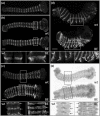Single locus affects embryonic segment polarity and multiple aspects of an adult evolutionary novelty
- PMID: 20796293
- PMCID: PMC2940778
- DOI: 10.1186/1741-7007-8-111
Single locus affects embryonic segment polarity and multiple aspects of an adult evolutionary novelty
Abstract
Background: The characterization of the molecular changes that underlie the origin and diversification of morphological novelties is a key challenge in evolutionary developmental biology. The evolution of such traits is thought to rely largely on co-option of a toolkit of conserved developmental genes that typically perform multiple functions. Mutations that affect both a universal developmental process and the formation of a novelty might shed light onto the genetics of traits not represented in model systems. Here we describe three pleiotropic mutations with large effects on a novel trait, butterfly eyespots, and on a conserved stage of embryogenesis, segment polarity.
Results: We show that three mutations affecting eyespot size and/or colour composition in Bicyclus anynana butterflies occurred in the same locus, and that two of them are embryonic recessive lethal. Using surgical manipulations and analysis of gene expression patterns in developing wings, we demonstrate that the effects on eyespot morphology are due to changes in the epidermal response component of eyespot induction. Our analysis of morphology and of gene expression in mutant embryos shows that they have a typical segment polarity phenotype, consistent with the mutant locus encoding a negative regulator of Wingless signalling.
Conclusions: This study characterizes the segregation and developmental effects of alleles at a single locus that controls the morphology of a lineage-specific trait (butterfly eyespots) and a conserved process (embryonic segment polarity and, specifically, the regulation of Wingless signalling). Because no gene with such function was found in the orthologous, highly syntenic genomic regions of two other lepidopterans, we hypothesize that our locus is a yet undescribed, possibly lineage-specific, negative regulator of the conserved Wnt/Wg pathway. Moreover, the fact that this locus interferes with multiple aspects of eyespot morphology and maps to a genomic region containing key wing pattern loci in different other butterfly species suggests it might correspond to a 'hotspot' locus in the diversification of this novel trait.
Figures





Similar articles
-
Conserved developmental processes and the formation of evolutionary novelties: examples from butterfly wings.Philos Trans R Soc Lond B Biol Sci. 2008 Apr 27;363(1496):1549-55. doi: 10.1098/rstb.2007.2245. Philos Trans R Soc Lond B Biol Sci. 2008. PMID: 18192179 Free PMC article. Review.
-
Evolutionary history of the recruitment of conserved developmental genes in association to the formation and diversification of a novel trait.BMC Evol Biol. 2012 Feb 15;12:21. doi: 10.1186/1471-2148-12-21. BMC Evol Biol. 2012. PMID: 22335999 Free PMC article.
-
Developmental and genetic mechanisms for evolutionary diversification of serial repeats: eyespot size in Bicyclus anynana butterflies.J Exp Zool B Mol Dev Evol. 2008 Mar 15;310(2):191-201. doi: 10.1002/jez.b.21173. J Exp Zool B Mol Dev Evol. 2008. PMID: 17577201
-
Concerted evolution and developmental integration in modular butterfly wing patterns.Evol Dev. 2003 Mar-Apr;5(2):169-79. doi: 10.1046/j.1525-142x.2003.03025.x. Evol Dev. 2003. PMID: 12622734
-
Butterfly eyespot patterns and how evolutionary tinkering yields diversity.Novartis Found Symp. 2007;284:90-101; discussion 101-15. doi: 10.1002/9780470319390.ch6. Novartis Found Symp. 2007. PMID: 17710849 Review.
Cited by
-
Butterfly eyespot serial homology: enter the Hox genes.BMC Biol. 2011 Apr 28;9:26. doi: 10.1186/1741-7007-9-26. BMC Biol. 2011. PMID: 21527048 Free PMC article.
-
Involvement of the conserved Hox gene Antennapedia in the development and evolution of a novel trait.Evodevo. 2011 Apr 19;2:9. doi: 10.1186/2041-9139-2-9. Evodevo. 2011. PMID: 21504568 Free PMC article.
-
Genetic basis of stage-specific melanism: a putative role for a cysteine sulfinic acid decarboxylase in insect pigmentation.Heredity (Edinb). 2012 Jun;108(6):594-601. doi: 10.1038/hdy.2011.127. Epub 2012 Jan 11. Heredity (Edinb). 2012. PMID: 22234245 Free PMC article.
-
Baculovirus-mediated gene transfer in butterfly wings in vivo: an efficient expression system with an anti-gp64 antibody.BMC Biotechnol. 2013 Mar 25;13:27. doi: 10.1186/1472-6750-13-27. BMC Biotechnol. 2013. PMID: 23522444 Free PMC article.
-
Development of an embryonic skeletogenic mesenchyme lineage in a sea cucumber reveals the trajectory of change for the evolution of novel structures in echinoderms.Evodevo. 2012 Aug 9;3(1):17. doi: 10.1186/2041-9139-3-17. Evodevo. 2012. PMID: 22877149 Free PMC article.
References
-
- Pigliucci M. What, if anything, is an evolutionary novelty? Phil Sci. 2008;75:887–898. doi: 10.1086/594532. - DOI
-
- Stebbins GL. Adaptive radiation of reproductive characters in angiosperms I: pollination mechanisms. Ann Rev Ecol Syst. 1970;1:307–326. doi: 10.1146/annurev.es.01.110170.001515. - DOI
-
- Kingsolver JG, Koehl MAR. Selective factors in the evolution of insect wings. Annu Rev Entomol. 1994;39:425–451. doi: 10.1146/annurev.en.39.010194.002233. - DOI
Publication types
MeSH terms
Substances
LinkOut - more resources
Full Text Sources

